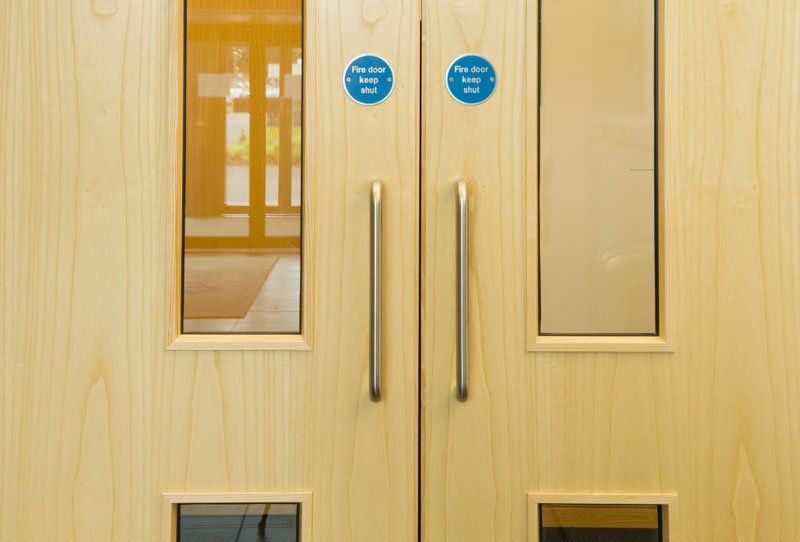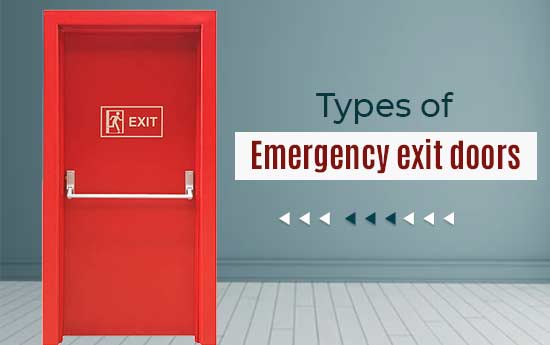Comprehending the Different Kinds Of Fire Doors for Improved Security
In the realm of building security, comprehending the numerous sorts of fire doors is paramount. These specialized doors not only serve as barriers versus fire and smoke but likewise play a crucial duty in ensuring secure evacuation during emergency situations. From typical fire-rated doors that shield against fires to acoustic fire doors that offer both fire resistance and sound insulation, each kind is developed with certain functions in mind. The combination of glass fire doors and the necessity of fire exit doors even more highlight the multifaceted nature of fire door applications. What essential elements must center managers take into consideration to make best use of the efficacy of these lifesaving barriers?
Standard Fire-Rated Doors
Conventional fire-rated doors are a vital element in guaranteeing building safety and conformity with fire guidelines. These doors are specifically created to stand up to the spread of fire and smoke, supplying vital security to residents and building. Created from products such as steel, gypsum, and fire-resistant timber, they can withstand heats and keep architectural stability for varying durations, normally varying from 20 mins to three hours.
The efficiency of common fire-rated doors is quantified by their fire-resistance ranking, which is identified via extensive screening under regulated problems. This ranking shows the duration throughout which the door can contain fires and warm, consequently allowing extra time for discharge and emergency feedback. In addition, these doors frequently include intumescent seals that increase when revealed to warmth, more preventing the flow of smoke and poisonous gases.
Setup of typical fire-rated doors need to follow strict building ordinance and requirements, such as those established by the National Fire Defense Association (NFPA) and the International Building Ordinance (IBC) Normal evaluations and upkeep are essential to make certain that these doors work correctly in an emergency situation. Correctly installed and kept fire-rated doors are vital in improving total structure security and minimizing fire-related dangers.
Smoke Doors
Smoke doors play a critical function in fire security by specifically dealing with the containment of smoke, which is often more harmful than fires during a fire case. Smoke inhalation can lead to severe respiratory system concerns, disorientation, and even casualties, making smoke doors an important element in emergency situation planning. These doors are designed to limit the motion of smoke in between various areas within a building, therefore supplying safer emptying courses and lowering prospective damage to home.

In addition, smoke doors are commonly equipped with automated closing mechanisms, caused by smoke detectors or fire alarms, to guarantee they close promptly during an emergency. why not try this out By containing smoke, you can find out more these doors aid keep reduced temperature levels and more clear visibility in getaway routes, making them an essential aspect in detailed fire safety and security strategies. Their correct installation and maintenance are important to make certain ideal efficiency when most required.
Acoustic Fire Doors
Acoustic fire doors supply a dual function in both fire safety and security and audio attenuation, making them an important addition to structures where sound control is essential. These doors are crafted to not just fulfill strenuous fire resistance standards however also to substantially lower audio transmission, therefore improving total building efficiency.
The building and construction of acoustic fire doors commonly includes a mix of thick materials and specialized seals. Additionally, the door structure and seals are developed to keep acoustic integrity while providing robust fire resistance.
Acoustic fire doors are especially helpful in environments where privacy and silent are extremely important, such as medical facilities, hotels, and schools. They aid to maintain a calm environment by decreasing the transmission of sound in between rooms or hallways while making sure compliance with fire safety and security laws. Along with their useful advantages, these doors can be customized to mix seamlessly with the architectural aesthetic appeals of a structure, guaranteeing that safety and security does not come at the cost of style.

Glass Fire Doors
Glass fire doors, frequently made use of in contemporary building designs, provide a mix of openness and security that standard fire doors can not match. These doors incorporate the aesthetic appeal of glass with vital fireproof residential or commercial properties, making them an ideal choice for contemporary structures. Engineered with specialized fire-resistant glazing, glass click here to find out more fire doors can hold up against heats and protect against the spread of flames and smoke for a specified period, typically varying from 30 to 120 mins.
The construction of glass fire doors entails several layers of tempered glass, usually treated with intumescent products that expand when subjected to heat, more enhancing their fireproof capabilities. These doors are not just functional in regards to fire security yet likewise permit for natural light to penetrate with rooms, adding to power effectiveness and an extra welcoming environment.
Furthermore, glass fire doors can be incorporated with various framework materials such as steel or aluminum, which give additional architectural assistance and toughness. Using such doors is especially advantageous in industrial, educational, and medical care settings where presence and safety are vital. By meeting rigid fire safety and security policies and preserving an open, modern-day visual, glass fire doors stand for a critical advancement in fireproof building.

Fire Leave Doors
Fire escape doors are an essential part of any type of building's safety and security framework, created to supply a swift and protected means of egress throughout emergencies. These doors are strategically located to ensure occupants can quickly and securely leave the facilities in the event of a fire or various other unsafe scenarios. Unlike typical doors, fire escape doors have to stick to strict regulatory standards, ensuring they can execute accurately under pressure.
A key attribute of fire escape doors is their capability to open easily from the within, typically outfitted with panic bars or push pads. This design facilitates fast evacuation and protects against bottlenecks that can take place during high-stress situations. In addition, fire exit doors are often built from fire-resistant products to stop the spread of fires and smoke, thus giving vital extra time for discharge and firefighting efforts.
One more crucial element is the clear signage and lighting related to fire exit doors. Correct signs ensures that these departures are quickly recognizable even in low-visibility conditions. Routine upkeep and inspections are important to ensure that these doors function appropriately when required. Ultimately, the efficiency of fire escape doors is a crucial aspect in guarding lives and lessening building damage during emergencies.
Conclusion
In recap, recognizing the numerous kinds of fire doors, consisting of common fire-rated doors, smoke doors, acoustic fire doors, glass fire doors, and fire departure doors, is necessary for boosting security in buildings. Each type offers details advantages, from fire and smoke control to seem insulation and aesthetic integration, guaranteeing comprehensive defense. Fire doors. Normal maintenance and compliance with safety criteria are imperative to assure their efficiency in protecting occupants and facilitating secure emptying during emergency situations